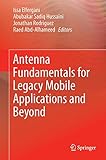Antenna Fundamentals for Legacy Mobile Applications and Beyond [electronic resource] / edited by Issa Elfergani, Abubakar Sadiq Hussaini, Jonathan Rodriguez, Raed Abd-Alhameed.
Contributor(s): Elfergani, Issa [editor.] | Hussaini, Abubakar Sadiq [editor.]
| Hussaini, Abubakar Sadiq [editor.] | Rodriguez, Jonathan [editor.]
| Rodriguez, Jonathan [editor.] | Abd-Alhameed, Raed [editor.]
| Abd-Alhameed, Raed [editor.] | SpringerLink (Online service)
| SpringerLink (Online service) .
.
Material type:  BookPublisher: Cham : Springer International Publishing : Imprint: Springer, 2018Edition: 1st ed. 2018.Description: XVII, 329 p. 267 illus., 164 illus. in color. online resource.Content type: text Media type: computer Carrier type: online resourceISBN: 9783319639673.Subject(s): Telecommunication
BookPublisher: Cham : Springer International Publishing : Imprint: Springer, 2018Edition: 1st ed. 2018.Description: XVII, 329 p. 267 illus., 164 illus. in color. online resource.Content type: text Media type: computer Carrier type: online resourceISBN: 9783319639673.Subject(s): TelecommunicationIntroduction -- Section I Evolution of the Mobile Antenna: 3G, 4G and beyond -- Fundamentals of antenna design, technologies and applications -- Section II Multi-band Antennas -- Design of Dual-band Planar Inverted F-L-Structure for frequency bands of the IEEE 802.11a/b/g, Bluetooth and ZigBee standards -- Double-Monopole Crescent-Shaped Antennas with High Isolation for WLAN and WIMAX Applications -- Electrically Small Planar Antenna based on Metamaterial -- Section III Wide band Antennas -- Effect of Aperture-Coupled Asymmetric Four (and five) DRA elements on the defected Ground Plan of Microstrip line for Ultra-Wideband -- A sample and compact planar ultra wide-band antenna with single or dual band-notched characteristics -- A Miniaturised Monopole Wideband Antenna with Tuneable Notch for WLAN/WiMAX Application -- Section IV MIMO Antennas -- Miniaturized EBG Two U-shape MIMO PIFA Antenna for mobile handset applications -- Compact design of MIMO antenna array Operating on 2.4 GHz and 5.2 GHz for wireless applications -- Compact Wide Band Printed MIMO/Diversity Monopole Antenna for GSM/UMTS and LTE Applications -- SECTION V Balanced Antennas -- Compact Structure of 3G Mobile Handsets wideband Balanced Antenna -- Coplanar-Fed Miniaturized Folded Loop Balanced Antenna for Use in WLAN Applications -- Performance of Dual-band balanced Antenna Structure for LTE -- SECTION VI mmWAVE Antenna for 5G -- Millimeter-Wave Pattern Reconfigurable Antenna -- Wide Angle Beam Scanning Antenna at 79 GHz for Short Range Automotive Radar Applications -- Conclusion.
This book highlights technology trends and challenges that trace the evolution of antenna design, starting from 3rd generation phones and moving towards the latest release of LTE-A. The authors explore how the simple monopole and whip antenna from the GSM years have evolved towards what we have today, an antenna design that is compact, multi-band in nature and caters to multiple elements on the same patch to provide high throughput connectivity. The scope of the book targets a broad range of subjects, including the microstrip antenna, PIFA antenna, and the monopole antenna to be used for different applications over three different mobile generations. Beyond that, the authors take a step into the future and look at antenna requirements for 5G communications, which already has the 5G drive in place with prominent scenarios and use-cases emerging. They examine these, and put in place the challenges that lie ahead for antenna design, particularly in mm-Wave design. The book provides a reference for practicing engineers and under/post graduate students working in this field.


There are no comments for this item.